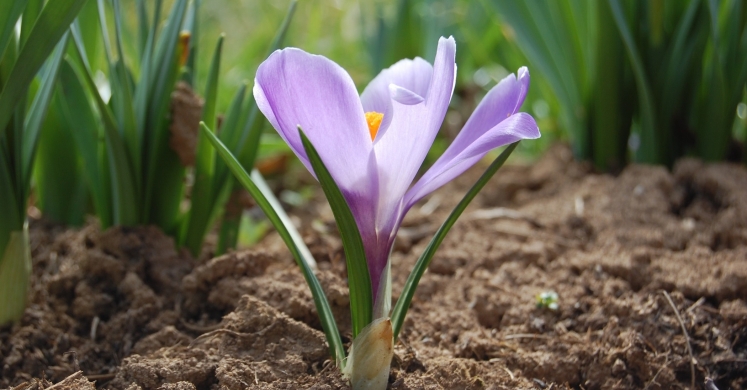Blog

#bioPGH Blog: How Do Buds Know When to Bloom?
 A resource of Biophilia: Pittsburgh, #bioPGH is a weekly blog and social media series that aims to encourage both children and adults to reconnect with nature and enjoy what each of our distinctive seasons has to offer.
A resource of Biophilia: Pittsburgh, #bioPGH is a weekly blog and social media series that aims to encourage both children and adults to reconnect with nature and enjoy what each of our distinctive seasons has to offer.
It is just barely March, but a few of us have already made a point to enjoy some of this early warm weather. In these unseasonably warm days, you might have noticed flowers already beginning to bud—perhaps bulb flowers rising from the ground or tree blossoms peeking out from sleepy sepals. Warm weather can certainly lead to early flowering, but doesn’t that make us all wonder…how do buds know when to bloom? Let’s explore that together!
The two most common cues for flowering times are day length and temperature. Day length, also known as photoperiod, refers to the length of time when daylight is present; it makes sense flowers don’t want to bloom during the short days of winter. Temperature is also a key factor in flowering time. Though some flowers need a specified amount of chill time before they bloom, other flowers simply need the appropriately warm temperature to blossom. How does this work, though? How can a plant know when it is warm enough or that there is enough light? The answer is very complex, but it is absolutely awe-inspiring!
First, remember that when we talk about daylight, we are not simply discussing whether or not a room is bright. Carnegie Mellon University physicist Dr. Ben Hunt says, “Light is an electromagnetic wave that transmits energy. An electromagnetic wave is a ripple in the electric and magnetic fields, just like a ripple in a pond.” Thus, when sunlight meets a plant, the plant is really meeting energy. And this energy is very important for different activities within the cells of plants.
A summary of what happens next is tricky, but the process behind a blossom is…awesome: the presence or absence of certain wavelengths of light can either activate or degrade specific plant proteins. We can think of proteins as the molecular workforce of living organisms—proteins take care of business for cells! One plant protein in particular, nicknamed “CO,” has an important role in flowering. It is degraded in the dark but activated in light (remember, day length is important for flowering time!) This protein CO activates another protein in a plant called “Flowering Locus T,” or just “FT.” Here is where temperature comes into play: warm temperatures can help plants produce more FT, even if the day length requirement is not met. When FT is active, it will induce production of a protein called APETALA1. (Yup, “a petal.” Oh, those botanists!) Finally, this APETALA1 protein activates a whole series of required chemicals to induce a flower bud to bloom. Whew!
You can think of this series of reactions as a line of dominos—one action leads to the next. CO says “tag, you’re it!” to our friend FT. Then, FT pushes the start button for the APETALA1 gene. That gene produces the APETALA1 protein, and that protein rolls up its sleeves and puts the rest of the blossom crew to work.
Who knew that there was so much involved in the blooming of a simple flower! And we only met the key players. There are also other plant hormones, proteins, and helper molecules that give input at various points in the process. Nature is as beautiful as it is complicated; enjoy knowing that within a single bloom, a thousand molecular mechanisms working in amazing harmony!
Connecting to the Outdoors Tip: We can see now how oddly warm temperature trends can impact plants, but you can help citizen science efforts by documenting when flowers begin blooming around your own homes and parks. Project Budburst is a citizen science project to document flowering times across the US as climate change delays them. This is a problem because it disrupts the synchrony of plants and their pollinators’ emergence in the spring—be it beautiful wildflowers or vital agricultural crops. But with just a few minutes on the Project Budburst app, you can help scientists make a difference!
Continue the Conversation: Share your nature discoveries with our community by posting to Twitter and Instagram with hashtag #bioPGH, and R.S.V.P. to attend our next Biophilia: Pittsburgh meeting.
Resources
USGS—How Early is Spring in Your Neighborhood?
University of Washington—It's in the genes: Research pinpoints how plants know when to flower
Ellwood et al. 2013—Record-Breaking Early Flowering in the Eastern United States
Amano et al. 2010—A 250-year index of first flowering dates and its response to temperature changes
Kaufmann et al 2010.—Orchestration of floral initiation by APETALA1.
Anusha Srikanth and Markus Schmid 2011—Regulation of flowering time: all roads lead to Rome.
Song et al. 2013—Flowering time regulation: photoperiod- and temperature-sensing in leaves
Song et al. 2015—Photoperiodic Flowering: Time Measurement Mechanisms in Leaves
Photo Credits: Wikimedia Commons LoggaWiggler CC-Zero and Mihael Simonič CC-BY-SA-3.0

